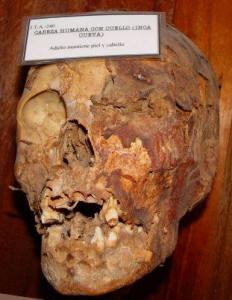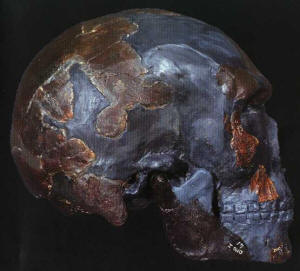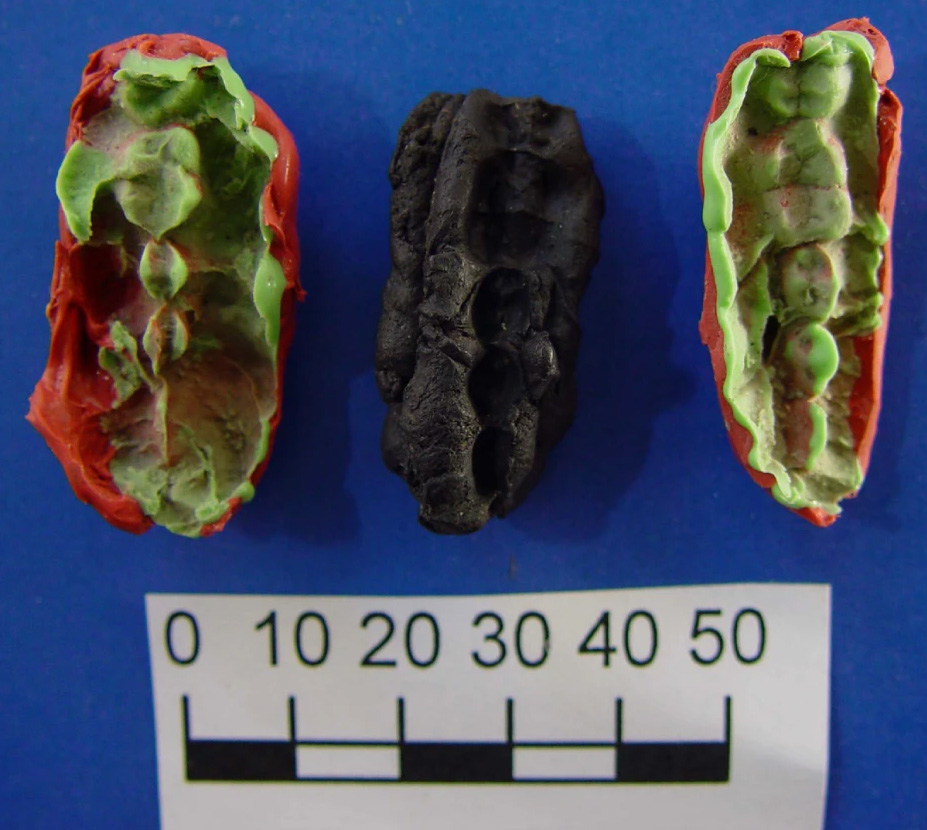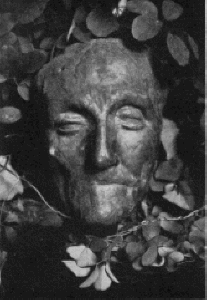Whole bodies
The most ancient surviving entire human body is
the mummy number EA 32751, formerly known as 'Ginger', and more
formally as Gebelein Man, radiocarbon-dated to 3341–3017 BCE. Currently
on display in Room 64 in the British Museum in London, Gebelein Man is thought
to have been discovered buried in desert sand in Gebelein in Egypt where
conditions can naturally preserve bodies, as the hot and dry sand
naturally absorbs the water that constitutes 75% of the human weight.
Without this moisture bacteria can't breed and cause decay, and so the
body is preserved. Though EA 32751's mummification may have been wholly
natural, since he was buried with pottery vessels it's likely that the
mummification was a result of the preservation techniques of those who
buried him. Stones may have been piled on top of the grave to prevent
the corpse from being eaten by jackals and other scavengers, and the
pottery might have held food and drink which may have been placed with
the body to sustain the deceased during the journey to the after life. A
CT scan in 2012 established that the body was that of a young man aged
18–21, who had been murdered by a stab to the back. [British
Museum;
BM blog;
Friedman et al.]

Mummy EA 32751
(Photo: © The
Trustees of the British Museum)
|
Body parts
The most ancient mummified human head is the well
preserved naturally mummified head found in 1936 by Justiniano Torres
Aparicio, with two other mummies, at the site
of Inca Cueva #4, level 1A, at 3680 m.o.s.l. [sic,
but I think this must mean metres above sea level], in the
Quebrada of Chulin (Prov. of Jujuy, Argentina). A sample
of temporal skin from the head of Chulina has been radiocarbon
dated as having a calibrated age of 6080 ± 100 years (within 82%
probability). [Dubal]

The naturally mummified human head labelled J.T.A.-240
in the Museum Torres
Aparicio (Photo: L. Dubal)
The remains of the world's oldest human
brain,
estimated to be over 5,000 years old, were found in 2009 in a cave in
south-eastern Armenia. An analysis performed by the Keck Carbon Cycle
Accelerator Mass Spectrometry Laboratory at the University of
California, Irvine, confirmed that one of three human skulls found at
the site contains particles of a human brain dating to around the first
quarter of the 4th millennium BCE. The team in Armenia, comprising 26
specialists from Ireland, the United States and Armenia, had been
excavating the three-chamber cave where the brain was found since 2007.
The skull with the brain was found in a chamber
that contained three buried ceramic vessels containing the skulls of
three women, about 11 to 16 years old. The cave's damp climate helped
preserve red and white blood cells in the brain remains. What part of the brain the 9 x 7 cm brain fragment
comes from is still being determined. Microscopic analysis revealed blood vessels and traces of a brain hæmorrhage, perhaps caused by a blow to the head. [Abrahamyan]
|
Fossilised bones
The earliest known fossilised bones of Homo
sapiens are known as Omo 1, having been found by Richard Leakey, between
1967 and 1974, at a site near the Omo River, in south-western Ethiopia.
Their dating was significantly revised in January 2022, and they are now
considered to be 230,000 years old, give or take 22,000 years. [Nature,
Journal of Human Evolution]
In 2017 it was announced that fossil
bones, teeth, and skulls, from five individuals, had been excavated at
Jebel Irhoud in Morocco which have been dated by hi-tech methods to be
between 300,000 and 350,000 years old. They are anatomically clearly H. sapiens.
[Ghosh]

Omo 1
(Photo: Michael Day) |
Hair
The oldest surviving human hair is found on the
Chinchorro mummies of Chile, the oldest of which—the so-called 'Black
Mummies' (given a clay mask coated with black manganese)—date to up to 5000 years before the present. [Archaeology]
In 2009 much older hair was recovered from
fossilized hyena dung found in Gladysvale Cave, near Johannesburg, South
Africa. Dating of the cave's limestone layers showed that the dung had
been deposited some time between 257,000 and 195,000 years ago. It is
not known, however, whether the hair is from H. sapiens or the coeval
H. heidelbergensis. [Hoffman,
Journal of Archaeological Science]

5000-year-old remains of a woman, mummified in the black style and
surrounded by whalebone,
recovered from the site of El Morro in downtown
Arica, Chile, in 1983
(Photo: © Philippe Plailly / EURELIOS) |
DNA
In April 2021 it was announced that entire genomes have been sequenced
for three male individuals dated to between 45,930 and 42,580 years ago,
from Bacho Kiro Cave, Bulgaria. All three had approximately 3.8%
Neanderthal ancestry, leading researchers to conclude that they were in
fact older than the previously sequenced genome from Ust'-Ishim in
western Siberia; two had Neanderthal ancestors about seven generations
back, and one—individual F6-620—had a Neanderthal ancestor less than six
generations back. [Nature,
Max
Planck Institute]
The most ancient DNA found in a living person was first identified in
2013, with the publication of an article in the
American Journal of Human Genetics, released on 7 March. The DNA
analysis of an African-American male from South Carolina was found to
contain single-nucleotide polymorphisms that contained vestigial
remnants of mutations of the Y chromosome that were estimated by an
international group of geneticists to have a time to the most recent
common ancestor corresponding to 338,000 years ago. This appreciably
predates the age of the earliest Homo sapiens fossils. [Discovery
News;
Examiner] |
Blood
Debate continues around the validity of
conclusions drawn from the analysis of blood protein residues on stone
tools. However, evidence of human blood does appear to have been found
on stone tools from the De Long Mountains of north-western Alaska,
believed to date from between 9570 and 8000 Before Present. [Arctic,
Vish]
In May 2012 it was reported that actual red blood
cells had been recovered from the wounds on the body of the famous
Tyrolean iceman, Ötzi. [Janko,
Stark, and Zink]
Menstrual blood was recovered in 2007 from
woven aprons worn by Native American women in SE Utah and northern
Arizona over a period extending back to 2400 BP. [Quids]

Red
blood cells recovered from Ötzi
the Iceman
(Photo: J. Roy. Soc. Interface)
|
Saliva
In 2019 an international
team of researchers successfully extracted sufficient DNA from a chewed
piece of birch pitch from Syltholm, on the island of Lolland, Denmark,
that they were able to recover a complete ancient human genome, as well
as microbial DNA reflecting the oral microbiome of the person who chewed
the pitch, as even plant and animal DNA that may have derived from a
recent meal. The pitch has a calibrated date of 5858–5661 BP. [Jensen et
al., Nature]
The same year human DNA
samples were extracted from chewed pitch dating to 9880–9540 BP, from
Huseby Klev, in western Sweden, although no whole genomes have been
reported. [Kashuba et al,
Nature]
|
Urine
In 2004 Greenwich workmen found a sealed jug
about 1.5m below ground. It was a bellarmine—a salt-glazed jar made in
the Netherlands or Germany, stamped with the face of Cardinal Roberto Bellarmino. When the jug was shaken it splashed and rattled, and the
Greenwich Maritime Trust asked retired chemist Alan Massey to study it.
Immediate X-ray revealed pins and nails stuck in
the neck, consistent with the jug having been buried upside down. CT
scans at Liverpool University showed it to be half-filled with liquid.
It was clear that this was a witch bottle.
Liquid was drawn through the cork of the
Greenwich bottle with a long-needled syringe. Complex chemical studies
that included recording a proton nuclear magnetic resonance spectrum,
and then gas chromatography / mass spectrometry analysis of organic
acids by Richard Cole (Leicester Royal Infirmary) and inorganic analysis
by Helen Taylor (British Geological Survey), allow Massey to say that
the liquid "is unequivocally human urine". Past claims for urine in
witch bottles have rested solely on inorganic material.
Cole identified cotinine, a metabolite of
nicotine: the urine had been passed by a smoker. [British
Archaeology]

CT scan of a 17th century 'witch bottle', showing human urine, pins and nails
(Photo: Mike Pitts / British Archaeology)
|
Faeces
A 2019
report
on 'Middle Stone Age humans in high-altitude Africa' reports "the
massive presence of human feces" at Fincha Habera rock shelter in
southern Ethiopia, dating from 47,000 to 31,000 years ago.
The earliest dateable human coprolites
(fossilized faeces) I've so far succeeded in locating on the Internet
were found at Wadi Kubbaniya in southern Egypt, and originate from
between 18,500 and 17,000 BP. [The
Antiquity of Man]
Actual desiccated paleofecal matter (not
fossilized) has survived in some very dry sites, such as the western
United States and Mexico. Some such matter, from Hidden Cave, Nevada,
has been dated to 3700–3400 BP. [Thorn]
The examples illustrated are from Hinds Cave, Texas, dated only as more
than 2000 years old. [Poinar
et al.]
The earliest faeces from a known, named,
individual is in the form of a lump found in a latrine box in 1937 which
was excavated in Aalborg, Denmark. The latrine was known to have been
used only by bishop Jens Bircherod (bishop there from 1694 to 1708),
whose manor was being excavated, and his wife. Analysis showed he had
eaten a cosmopolitan diet including grapes, cloudberries, figs, nuts,
and pepper, as well as buckwheat, which was known to be a local
speciality on the Danish island of Funen where the bishop grew up. The
faecal evidence of his diet is consistent with the opulent dinners he
noted in his diaries. [msn;
an image is to be found
here]

|
Semen
Semen can be cryogenically preserved, and in 2007
a baby was born whose father's sperm had been stored for 22 years, which
still appears to be the record. [Planer]
However, the British Human
Fertilisation & Embryology Authority states that in certain
circumstances a storage period of up to 55 years is permissible.
According to D.P. Lyle's Forensics for Dummies, 2nd edition,
2016, "dried semen stains can remain identifiable and usable for DNA
analysis for many years. Just ask Bill about Monica's blue dress." |
Milk, tears, snot
No information located.
|
Full references for printed works
Joanna
Ebenstein (2016) The Anatomical Venus. London: Thames
& Hudson
Paul Pettit
(2013) 'The Rise of Modern Humans', in Chris Scarre, ed.
(2013) The Human Past. World Prehistory & the Development
of Human Societies. 3rd edn, London: Thames & Hudson
Julius von
Schlosser (1910–1911) 'History of Portraiture in Wax'
('Geschichte der Porträtbildnerei in Wachs'), translated as
an appendix in Roberta Panzanelli, ed. (2008) Ephemeral
Bodies. Wax Sculpture and the Human Figure. Los Angeles:
Getty Research Institute
|












